Who are the major theorists and theories organizing the study of development?
Learning Objectives
- Differentiate Freud’s psychosexual stage theory from Erikson’s psychosocial stage theory
- Explain the behavioral approaches to understanding development
- Explain Piaget, Vygotsky, and the information processing approaches to understanding development
- Describe humanistic and evolutionary approaches to development
- Describe Bronfenbrenner’s bioecological systems approach
History of Developmental Psychology

The scientific study of children began in the late nineteenth century and blossomed in the early twentieth century as pioneering psychologists sought to uncover the secrets of human behavior by studying its development. Developmental psychology made an early appearance in a more literary form, however. William Shakespeare had his melancholy character, “Jacques” (in As You Like It), articulate the “seven ages of man,” which included three stages of childhood and four of adulthood.
Two early scholars, John Locke and Jean-Jacques Rousseau proposed theories of human behavior that are the direct ancestors of the major theoretical traditions of developmental psychology today (Vasta et al, 1998, p. 10). Locke, a British empiricist, adhered to a strict environmentalist position, that the mind of the newborn as a tabula rasa (“blank slate”) on which knowledge is written through experience and learning. Rousseau, a Swiss philosopher who spent much of his life in France, proposed a nativistic model in his famous novel Emile, in which development occurs according to innate processes progressing through three stages: Infans (infancy), puer (childhood), and adolescence. Rousseau detailed some of the necessary progression through these stages in order to develop into an ideal citizen. Although some aspects of his text were controversial, Rousseau’s ideas were strongly influential on educators at the time.
Developmental theories can be divided into a few general camps: psychodynamic, behavioral, cognitive, humanistic, evolutionary, and systems theories. Each theory and their proponents will be briefly reviewed. You can also check out the videos at the end for more in-depth coverage of each theory. As we cover the entire lifespan, each theory will be covered in greater detail. At this point, it’s helpful to start learning the main ideas, players, and what they say about how we develop. Which theory most closely aligns with your views on human development?
Developmental Theories
Psychodynamic Theories
Psychodyamic theories focus on unconscious conflicts and drives. Unconscious refers to parts of our mind that we are unaware of. Originally referred to as psychoanalytic theories, the term psychodynamic reflects modern interpretations. Two of the most prominent psychoanalytic theorists were Sigmund Freud and Erik Erikson.
Psychosexual Theory
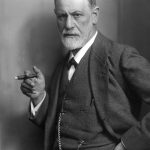
A name you are probably familiar with who was influential in the study of human development is Sigmund Freud (1856-1939). Sigmund Freud’s stage theory of psychosexual development grew out of his psychoanalytic approach to human personality and psychopathology. Freud based his model of child development on his own and his patients’ recollections of their childhood. He developed a stage model of development in which the libido, or sexual energy, of the child, focuses on different “zones” or areas of the body as the child grows to adulthood. Freud’s model is “interactionist” since he believed that although the sequence and timing of these stages are biologically determined, successful personality development depends on the experiences the child has during each stage. Although the details of Freud’s developmental theory have been widely criticized for lacking evidence and being difficult to test, his emphasis on the importance of early childhood experiences, prior to five years of age, has had a lasting impact.
Freud emphasized the importance of early childhood experiences in shaping our personality and behavior. In our natural state, we are biological beings. We are driven primarily by instincts. During childhood, however, we begin to become social beings as we learn how to manage our instincts and transform them into socially acceptable behaviors. The type of parenting the child receives has a very powerful impact on the child’s personality development. We will explore this idea further in our discussion of psychosexual development, but first, we must identify the parts of the “self” in Freud’s model, or in other words, what constitutes a person’s personality and makes us who we are.
Psychosocial Theory

Erik Erikson (1902-1994) also adopted the psychoanalytic approach, but he diverged from Freud by focusing more on social influences in personality development. Instead of a psychosexual model, Erikson proposed eight stages of psychosocial development: trust versus mistrust, autonomy vs. shame/doubt, initiative vs. guilt, identity vs. role confusion, intimacy, vs. isolation, generativity vs. stagnation, and integrity vs. despair. Each stage included a conflict or developmental task to progress through each stage. His theory covered the entire lifespan, from infancy through late adulthood, as opposed to Freud, whose last stage ended after adolescence. Erikson’s stages catalyzed research into social, emotional, and identity development, but it was criticized for lacking adequate detail in how people resolve each crisis. People may not progress through these stages in the same order, and some stages may be limited to certain cultural and historical contexts. However, many find his stages to be a useful summary of social tasks across the lifespan.
Behavioral Theories
In sharp contrast to the more subjective approach espoused by Freud and Erikson, behaviorism, or learning theory, sought to establish psychology as a rigorous scientific discipline by only focusing on observable behaviors. Behaviorism emphasized the role of nurture, or the environment, in human development. Behaviorists only studied actions and what you could see, essentially neglecting the mind. They used human and animal models to demonstrate how learned behaviors could be gradually acquired, which was consistent with non-stage theories.
Classical Conditioning
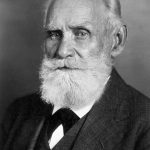
The Russian physiologist Pavlov (1849-1936) did not consider himself a psychologist: he worked on digestion in dogs, which led to a Nobel Prize. He discovered the theory of classical conditioning almost by accident when working with dogs in his lab. He noticed that every time he fed his dogs, they would salivate. Over time, the dogs started salivating even before the food arrived, such as when they saw the lab assistant approach or heard their footsteps coming down the hallway. This led Pavlov to investigate how we can learn automatic reactions by associating two stimuli together, which is classical conditioning. Although classical conditioning explains a small subset of developmental behaviors, it’s influential in learned emotional responses and paved the way for behavioral theories.
Watson (1878-1958) was the founder of the field of behaviorism, and he expanded upon Pavlov’s research. He believed, based on Locke’s environmentalist position, that human behavior can be understood in terms of experiences and learning. He believed that all behaviors are learned, or conditioned, as evidenced by his famous “Little Albert” study, in which he classically conditioned an infant to fear a white rat.
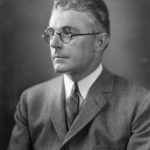
In Watson’s book, Psychological Care of Infant and Child in 1928, he explained that children should be treated as a young adult—with respect, but also without emotional attachment. In the book, he warned against the inevitable dangers of a mother providing too much love and affection. Watson explained that love, along with everything else as the behaviorist saw the world, is conditioned. Watson supported his warnings by mentioning invalidism, saying that society does not overly comfort children as they become young adults in the real world, so parents should not set up these unrealistic expectations. His book became highly criticized for being cold and his research and personal life for ethical lapses (he had an extramarital affair with his graduate assistant, Rosalie Rayner) but he was still influential in promoting more research into early childhood behavior and development.
Operant Conditioning
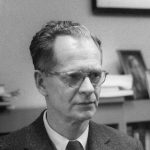
According to a 2002 survey, another behaviorist, B.F. Skinner was considered the most eminent psychologists of the 20th century (Haggbloom et al., 2002). Like other behaviorists, he argued for nurture and the environment in shaping development. Skinner thought that all behavior was learned and proposed a theory of operant conditioning, which is familiar to any parent or child. Our behavior is shaped by the consequences, rewards and punishments, which Skinner termed reinforcement and punishment. If the consequences of your action make your behavior more likely to happen in the future, then it’s considered reinforcement. If the consequences make your behavior less likely, then it’s punishment. If you cram for an exam and do well, you’re like to cram again in the future, so that cramming behavior is reinforced. However, if you cram for unit exams but then forget everything for the final exam, you recognize the strategy is ineffective for long-term learning, and you (hopefully) become less likely to cram in the future. That’s punishment. Skinner is also known for some idiosyncratic applications of operant conditioning like a temperature-controlled crib for babies and pigeon-guided precision bombs (GIY – google it yourself, for more info).
Social Cognitive Theory (Social Learning)
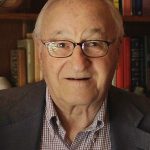
Bandura (1925-2021) extended behavioral theory by considering social and cognitive influences. He was not a radical behaviorist like Watson or Skinner, but most famous for his social cognitive theory and Bobo doll experiments. Bandura believed that children learn by observing others, which is also referred to as social learning, observational learning, or modeling.
Cognitive Theories
Cognitive is another word for “thinking.” Cognitive theories focus on the mind and and how thinking develops.
Piaget’s Cognitive Development Theory
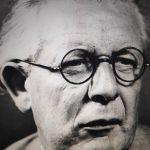
Jean Piaget (1896-1980) ranked behind Skinner as the second most eminent psychologist of the 20th century, and his stage theory of cognitive development revolutionized our view of children’s thinking and learning. His interest lay in children’s knowledge, their thinking, and the qualitative differences in their thinking as it develops. Although he called his field “genetic epistemology,” stressing the role of biological determinism, he also assigned great importance to experience. In his view, children “construct” their knowledge by building schemas, or mental models.

To Piaget, knowledge grows through processes of “assimilation,” in which people evaluate and try to understand new information based on their existing knowledge of the world, and “accommodation,” in which they expand and modify their mental models based on new experiences. If a young child has a pet cat, they develop a schema that cats are typically four-legged, furry, and they meow. When they see a new cat that has a different color coat, they assimilate it into their current cat category or schema. However, if they see a furry, four-legged creature that barks, they may mistakenly identify it as a cat, but be corrected that it’s a dog. They need to accommodate their schema, or mental categories, and create a new category for dogs.
Piaget proposed four stages of cognitive development from infancy through adolescence, and his work inspired more research than any other theorist. Many of his concepts are still foundational to developmental psychology. More recent cognitive psychologists found that Piaget underestimated the cognitive capabilities of infants and children and overestimated the abilities of adolescents. Piaget was also criticized for his stage approach, which doesn’t capture all the individual differences in cognitive development.
Vygotsky’s Sociocultural Theory
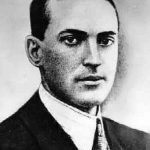
Although Lev Vygotsky was born in the same year as Piaget, he died at age 37 of tuberculosis. He was a Russian psychologist interested in how children’s thinking developed. He and Piaget both believed in the importance of the child being actively involved in their learning, but Vygotsky differed from Piaget in that his sociocultural theory focused more on social influences and how cultural tools transform one’s thinking. Vygotsky did not propose a series of stages like Piaget. Two of Vyogotsky’s concepts, the zone of proximal development, and scaffolding, are still influential in education circles. The zone of proximal development refers to the skills or abilities that a novice can accomplish if they have help from a more skilled person. Scaffolding, like the construction term, refers to temporary supports that more skilled people provide to help children advance in their cognitive and physical skills.
Information Processing
Information processing theory is a set of cognitive theories that emerged from the cognitive revolution of the 1950’s and 60’s. They focus on how information “flows” through the mind and often adopt a computer metaphor of the mind. As the name suggests, what’s central are the processes of the mind, like attention, memory, reasoning, problem-solving, and planning. Although the computer metaphor is limited, most modern cognitive theories of development adopt an information processing approach when investigating how different thinking processes change over time. When we learn more about how memory changes in childhood and late adulthood or how modern technology affects attention, we’ll consider the information processing perspective.
Humanistic Theories
Emerging around the same time as information processing theories, humanistic theories focused on the positive aspects of human nature. Whereas prior developmental theories, like psychoanalytic and behavioral, thought free will was an illusion, humanistic theories embraced free will and the power of personal choice. Prominent humanistic theories, like Abraham Maslow, proposed a hierarchy of needs with self-actualization at the top. Self-actualization is the motivation to achieve our highest potential. According to Maslow’s hierarchy of needs, humans can live their best lives when their lower needs are met, including basic needs, safety, love and belonging, and esteem. Carl Rogers emphasized the importance in humans receiving unconditional positive regard to optimize their development: all people should be afforded dignity and respect without conditions. These theories have been immensely influential in therapy and education but are criticized for lacking scientific rigor.
Evolutionary Theory

The work of Charles Darwin, the British biologist famous for his theory of evolution, has been applied to studying human development. The human species shares a long evolutionary history and that history, over thousands of years, has influenced how we think and act today across the lifespan. Ways of thinking and behaving that helped our ancestors survive and reproduce were more often passed down through generations. Evolutionary theories are helpful for tackling many of the “why” questions of human behavior, such as why do we think and act the way we do? For example, why do humans have one of the longest childhood periods of any mammal? From an evolutionary view, extending childhood for so long is risky in delaying reproductive age, because one could die before that age. But that risk could be outweighed by the benefit of developing a large brain capable of learning complex social skills (Machluf et al., 2014). In short, our advanced human social skills, which take a lengthy childhood to develop, promoted survival and reproduction. Evolutionary theories are important for their theoretical contributions, but are notoriously difficult to test.
Bronfenbrenner’s Ecological Systems Theory
Another psychologist who recognized the importance of the environment on development was American psychologist, Urie Bronfenbrenner (1917-2005), who formulated the ecological systems theory to explain how the inherent qualities of a child and their environment interact to influence how they will grow and develop. The term “ecological” refers to a natural environment; human development is understood through this model as a long-lasting transformation in the way one perceives and deals with the environment. Bronfenbrenner’s ecological theory stresses the importance of studying children in the context of multiple environments because children typically find themselves enmeshed simultaneously in different ecosystems. Each of these systems inevitably interact with and influence each other in every aspect of the child’s life, from the most intimate level to the broadest. Furthermore, he eventually renamed his theory the bioecological model in order to recognize the importance of biological processes in development. However, he only recognized biology as producing a person’s potential, with this potential being realized or not via environmental and social forces. Those environmental contexts can be conceptualized as different systems.
An individual is impacted by microsystems such as parents, siblings, or friends; those who have direct, significant contact with the person. The influence is bidirectional, meaning the person influences their friends and is influenced by them. The relationships between people surrounding the person also influence them. This is considered the mesosystem: the forces and connections between the people surrounding the child. A good example is the relationship between parents or the relationship between a parent and the child’s teacher. The mesosystem has also been interpreted to reflect the interactions between systems. The next level is the larger contexts of the community, referred to as the exosystem. The exosystem includes the social settings that do not directly involve the child, such as community structures, transportation, mass media, local industries, hospitals, and school systems. The community is influenced by the macrosystem, which is the overarching cultural context, such as religious beliefs, political systems, global economic conditions, war, technological trends, values, philosophies, and a society’s responses to the global community. In sum, a child’s experiences are shaped by larger forces such as the family, neighborhood, culture, and the interactions among them. Remember, the influence is bidirectional: children also shape their families and other contexts. All of this occurs within the relevant historical context and timeframe, or chronosystem. The chronosystem refers to time and considers any changes in the child and the environment over time, including any historical events. The chronosystem consists of all the experiences that a person has had during their lifetime.
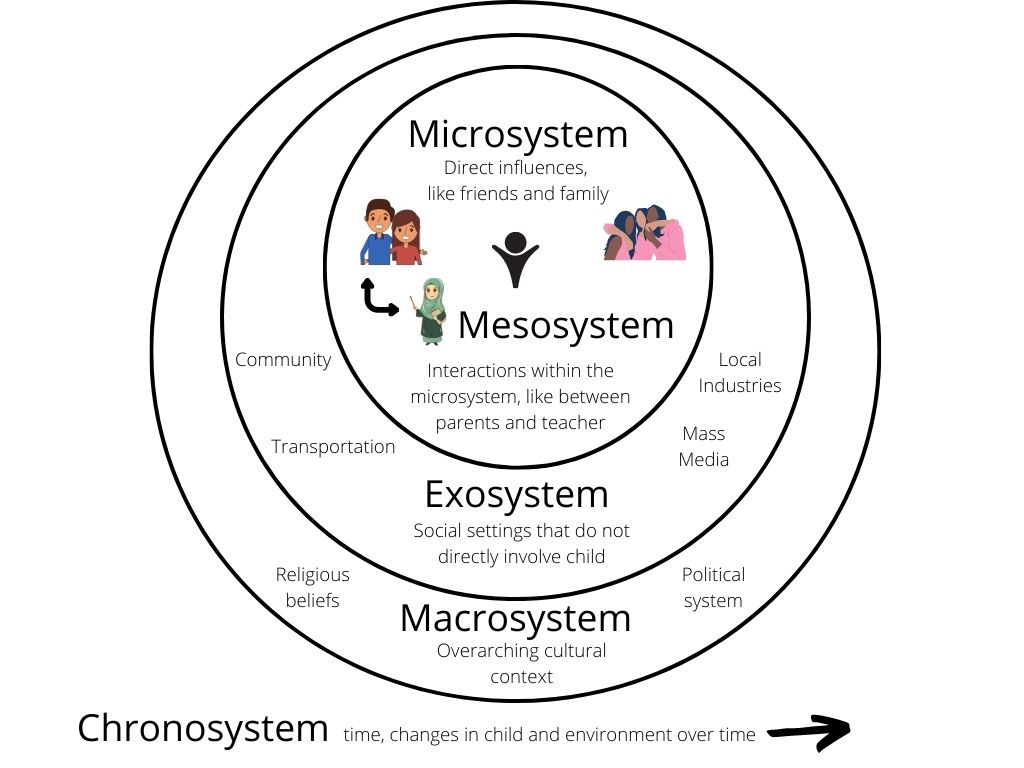
Comparing and Evaluating Lifespan Theories
Developmental theories provide a set of guiding principles and concepts that describe and explain human development. Some developmental theories focus on the formation of a particular quality, such as Piaget’s theory of cognitive development. Other developmental theories focus on growth that happens throughout the lifespan, such as Erikson’s theory of psychosocial development. It would be natural to wonder which of the perspectives provides the most accurate account of human development, but clearly, each perspective is based on its own premises and focuses on different aspects of development. Many lifespan developmentalists use an eclectic approach, drawing on several perspectives at the same time because the same developmental phenomenon can be looked at from a number of perspectives.
Throughout the course, we’ll explore and apply the major theories in greater depth. The goal right now is to introduce you to different ways of thinking about the lifespan and some of advantages and limitations of each approach. Recall the major issues considered in human development examine if development is continuous or discontinuous (non-stage or stage), if it is the same for everyone or distinct for individuals (one course of development or many), and if development is more influenced by nature or by nurture.
